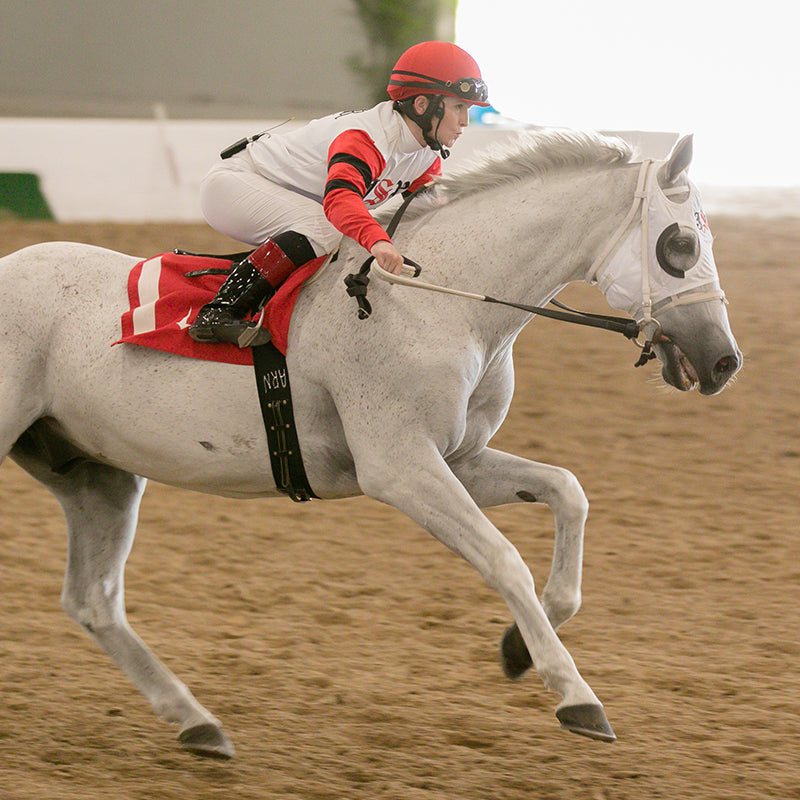

Thoroughbred
Breed History

The Thoroughbred’s ancestry traces back more than 300 years to three foundation stallions: the Darley Arabian, the Godolphin Arabian and the Byerly Turk. Named for their respective owners—Thomas Darley, Lord Godolphin and Captain Robert Byerley (the second "e" was accidentally dropped)—these stallions were imported into England in the late 1600s and early 1700s and bred to the stronger but less precocious native mares.
The result was a horse that could carry weight with sustained speed over extended distances, qualities that brought a new dimension to the burgeoning sport of horse racing.
So began a selective breeding process that continues to this day, breeding the best stallions to the best mares, with the proof of excellence established on the racecourse.
Although all modern Thoroughbreds trace their lineage to at least one of the foundation stallions, it is the Darley Arabian’s great-great grandson Eclipse from which 80% of modern Thoroughbreds descend.
Breed Standards
Thoroughbreds range from about 15.2 to 17 hands high. Their build is athletic, with a deep chest, long neck, lean body type, and long legs. The most common colors found are bay, brown, chestnut, grey, black, palomino and roan. Pinto patterns, including genetically-distinct "dominant white" pattern, can also occur.
For racing purposes, all Thoroughbreds in the Northern Hemisphere turn one year older on January 1st of each year, and those in the Southern Hemisphere on August 1st of each year, regardless of their actual birthday. This helps standardize playing fields for competitions.
The Breed Today
Thoroughbreds are known for their agility, grace, speed, stamina and courage, making them ideally suited for any number of disciplines beyond the racetrack. Many retired racehorses are successfully transitioned into second careers - organizations such as the Retired Racehorse Project have helped increase demand for these horses for a variety of disciplines. Enthusiasts often refer to off-track Thoroughbreds as "OTTBs." These horses can compete at the highest levels of international competition in eventing, show jumping and dressage and also make outstanding hunters, steeplechasers, barrel racers and polo mounts. They are also used by mounted police patrols and recreational riders who appreciate their intelligence and versatility.

Old Ironsides, an off-track Thoroughbred who transitioned to a career in eventing.
Thoroughbred Racing
Although there are records of horse racing on Long Island as far back as 1665, the introduction of organized Thoroughbred racing to North America is traditionally credited to Gov. Samuel Ogle of Maryland, who first staged a Thoroughbred race “in the English style” at Annapolis in 1745.
Each year, more than 60,000 Thoroughbreds compete for approximately $1 billion in purse money at racetracks across the United States. The sport’s showcase events are the Triple Crown in the spring and Breeders’ Cup World Championships in the fall.
Winning the Triple Crown is one of the most elusive and coveted achievements in all of sports. The series consists of three races within a five-week span and only 3-year-olds are eligible, meaning a Thoroughbred has only one shot at Triple Crown glory.
On the first Saturday in May is the Kentucky Derby, contested at 1 ¼ miles at Churchill Downs in Louisville, Ky. Two weeks later is the 1 3/16-mile Preakness Stakes at Pimlico Race Course in Baltimore, Md. Three weeks following in Elmont, N.Y. is the Belmont Stakes, dubbed the “Test of the Champion” because one lap around Belmont Park’s huge 1 ½-mile oval is the longest distance most of its entrants will ever race.
To date, only 13 horses have won the Triple Crown. American Pharoah made history as the first Triple Crown winner in 37 years in 2015, and Justify followed with another victory in 2018.
In addition to the “classic” races for 3-year-olds each spring, Thoroughbred racing has had a championship event in the fall known as the Breeders’ Cup World Championships since 1984. The Breeders’ Cup is North America’s richest racing event, with $26 million in prize money up for grabs in 15 races over two days. The event annually attracts many of the best Thoroughbreds, jockeys and trainers from around the world.
The Breeders’ Cup is generally held on the last weekend of October or the first weekend of November, and the host track usually changes from year-to-year.

For additional information, contact:
The Jockey Club
40 East 52nd Street
New York, NY 10022
(212) 371-5970
www.jockeyclub.com
Blog posts
-

-

April Fools' Day 2025 Test Run Giveaway!
Read nowEnter for your chance to win a one of three Breyer test run models!
-

A Special Edition of Your Favorite Pal!
Read nowWe're celebrating Pal O' Mine's 25th birthday in a very special way!


